Podcast
Questions and Answers
What is the main function of the inner membrane of mitochondria?
What is the main function of the inner membrane of mitochondria?
- To store mtDNA
- To generate energy for the cell through cellular respiration
- To allow certain substances to pass through
- To increase surface area through folding into cristae (correct)
What is the process by which mitochondria produce ATP?
What is the process by which mitochondria produce ATP?
- Citric acid cycle
- Chemiosmosis (correct)
- Electron transport chain
- Glycolysis
What is the process by which damaged or dysfunctional mitochondria are removed?
What is the process by which damaged or dysfunctional mitochondria are removed?
- Autophagy
- Mitophagy (correct)
- Fission
- Fusion
Which of the following diseases has been implicated in mitochondrial dysfunction?
Which of the following diseases has been implicated in mitochondrial dysfunction?
What is the role of microtubules in mitochondrial dynamics?
What is the role of microtubules in mitochondrial dynamics?
What is the significance of mtDNA in mitochondria?
What is the significance of mtDNA in mitochondria?
Study Notes
Structure and Function
- Mitochondria are organelles found in eukaryotic cells, with two main parts:
- Outer membrane: permeable, allowing certain substances to pass through
- Inner membrane: impermeable, folded into cristae to increase surface area
- Mitochondria have their own DNA, known as mtDNA, which is separate from nuclear DNA
Energy Production
- Mitochondria generate most of the energy for the cell through cellular respiration
- Process involves:
- Glycolysis: glucose broken down into pyruvate
- Citric acid cycle (Krebs cycle): pyruvate converted into acetyl-CoA
- Electron transport chain: energy from acetyl-CoA used to generate ATP
- Mitochondria produce ATP through chemiosmosis, using the energy from the electron transport chain
Dynamics and Movement
- Mitochondria can move within the cell along microtubules, allowing them to reach areas of high energy demand
- Mitochondrial dynamics involve:
- Fission: division of mitochondria to increase number and distribution
- Fusion: merging of mitochondria to share contents and reduce stress
- Mitophagy: removal of damaged or dysfunctional mitochondria through autophagy
Mitochondrial Function in Health and Disease
- Mitochondrial dysfunction has been implicated in various diseases, including:
- Neurodegenerative disorders (e.g., Alzheimer's, Parkinson's)
- Metabolic disorders (e.g., diabetes, obesity)
- Cancer
- Mitochondrial function also plays a role in aging and age-related diseases
Structure and Function
- Mitochondria are organelles found in eukaryotic cells, comprising two main parts: outer membrane (permeable) and inner membrane (impermeable with cristae to increase surface area)
- Mitochondria have their own DNA, known as mtDNA, separate from nuclear DNA
Energy Production
- Mitochondria generate most of the cell's energy through cellular respiration, involving three stages: glycolysis, citric acid cycle (Krebs cycle), and electron transport chain
- Energy from acetyl-CoA is used to generate ATP through chemiosmosis in the electron transport chain
Dynamics and Movement
- Mitochondria can move within the cell along microtubules to reach areas of high energy demand
- Mitochondrial dynamics involve three processes: fission (division to increase number and distribution), fusion (merging to share contents and reduce stress), and mitophagy (removal of damaged or dysfunctional mitochondria)
Mitochondrial Function in Health and Disease
- Mitochondrial dysfunction is implicated in various diseases, including neurodegenerative disorders (Alzheimer's, Parkinson's), metabolic disorders (diabetes, obesity), and cancer
- Mitochondrial function also plays a role in aging and age-related diseases
Studying That Suits You
Use AI to generate personalized quizzes and flashcards to suit your learning preferences.
Description
Learn about the structure and function of mitochondria, including their membranes, DNA, and role in energy production through cellular respiration.




